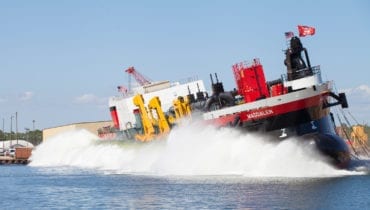The Dredging Contractors of America (DCA) Notifies Congress that the Congressional Research Service’s (CRS’s) Latest Report on Dredging is Fatally Flawed
“Notably, the author of this CRS report did not contact a single dredging company in the United States in the formulation of this report,” said William P. Doyle, CEO & Executive Director of the Dredging Contractors of America. Mr. Doyle continued, “I don’t like having to publish this rebuttal, but the CRS report is blatantly false and misleading. And if you don’t knock something like this down immediately, it’ll take on a life of its own, and then it gets passed around and cited as gospel.” Doyle finished, “This CRS dredging report amounts to nothing more than classic fake news published by a government researcher who does not even try to pretend to be objective.”
Below is a summary explanation of the biased CRS report that DCA sent to Congressional leaders this week.
Originally published in part by DredgeWire online, June 20, 2019.
Dear Chairman DeFazio and Ranking Member Graves:
The recent Insight Report –Harbor Dredging: Issues and Historical Funding (June 14, 2019) (2019 Dredging CRS Report) authored by John Frittelli is completely one-sided, biased and inaccurate. Mr. Frittelli is a Congressional Research Service (“CRS”) transportation specialist. It is evident that this entire report is nothing more than a long-standing and continued attack on the Jones Act by Mr. Frittelli.[1] CRS’s analysis of government contracting is fatally flawed and appears to be nothing more than a lazy attempt to justify this report.
We will address CRS’s inaccuracies below. The CRS did not contact a single dredging company in the United States in the formulation of this report.
The U.S. Dredging Fleet
CRS’s report claims that there is a limited supply of dredging vessels and that the fleet is old and small. This is false. The private sector dredging industry builds ships in accordance with market demand. In 2018, the private sector U.S.-flagged hopper dredging fleet capacity increased by 34% with the addition of two large new-build vessels built in U.S shipyards by U.S. workers. In fact, the U.S. dredging industry continues to spend billions of dollars recapitalizing its operations. The American dredging industry is amidst a $1.5 billion dredging fleet expansion. New investments include four large cutterhead suction dredges, two large hopper dredges, and approximately 50 barges built in shipyards across the United States, including Eastern Shipbuilding in Panama City, FL, Conrad Shipyard in Morgan City, LA, and Halimar Shipyard, also in Morgan City. In addition, Callan Marine is constructing a massive 32-inch hydraulic cutterhead suction dredge at C&C Marine Shipyard in Belle Chasse, LA (to be delivered in Q4 2019). The Dutra Group is currently building two 6,000 cubic yard hydraulic dump scows at Corn Island Shipyard in Grandview, IN. Separately, Weeks Marine is building a 30-inch cutterhead suction dredge at C&C Marine Shipyard (to be delivered in August 2019). Additionally, Manson Construction Co. has commenced the design phase of a large-scale, self-propelled Glenn Edwards Class hopper dredge, and Cashman Dredging is procuring long-lead time equipment for the construction of two 6,000 cubic yard hopper dredges.
Hopper Dredge Utilization in the United States
CRS claims that hopper dredges are the preferred type of dredge for dredging coastal harbors. This is another inaccurate and misleading claim. Ports in the U.S. are not dredged by hopper dredges alone. Some of the major harbor dredging projects cannot use hopper dredges because of environmental restrictions (i.e. turbidity), geotechnical formations, and the type of material to be dredged. For instance, in Boston, MA hopper dredges cannot be used for dredging – the work requires clamshell dredges and mechanical dredging. In April the Army Corps of Engineers reported private sector dredging companies Cashman Dredging and Dutra Group reached an Army Corps milestone with 4 million cubic yards dredged. Furthermore, in Tampa, FL the tool used to complete the Big Bend dredging project required cutterhead suction dredging and not hoppers. This Tampa project was completed a year ahead of schedule in April 2019 by Great lakes Dredge & Dock Company “thanks to a couple of especially powerful suction dredges”. In addition, Charleston, SC is using a combination of hopper and cutterhead suction dredges. According to the Army Corps of Engineers, GLDD’s cutterhead suction dredges Texas and Carolina, the two largest dredges of their kind in North America, for most of the work. There are also 40 support vessels involved in the dredging operations. In the third phase of dredging at Charleston Harbor, hopper dredges are precluded from being utilized because of environmental regulations related to turbidity. It is apparent that Mr. Frittelli has not taken the time to learn and understand the different equipment requirements for dredging projects in the United States, as limited by environmental restrictions and geotechnical formations.
False and Misleading Contracting Claims by Mr. Frittelli
As a precursor, CRS relies on the Institute for Water Resources (IWR) contract data to form his conclusions related to awarded dredging contracts to the U.S. private sector. IWR data year-over-year is incomplete. For instance, the IWR contract data shows that 130 dredging contracts[3] were awarded in 2018 by the Army Corps of Engineers. The IWR database is not accurate[4], as there were 162 contracts awarded in 2018 by the Army Corps of Engineers.
Importantly, CRS does not understand contracting methods utilized by the Army Corps of Engineers. The Army Corps uses a variety of different contracting mechanisms to procure dredging services, including Invitation for Bid (IFB), Request for Proposal (RFP), and Multiple Award Task Order Contract (MATOC). Bid results on contracts procured as IFBs are fully transparent, but not on RFPs and MATOCs, which are a form of an RFP. For example, the number of bidders and government estimate are not released under a MATOC or RFP. Rather than reporting the true number of bidders on MATOC or RFP projects in the IWR database, the Army Corps reports, as a placeholder, a single bid which skews the data rendering it inaccurate and incomplete.
Below is an examination of the false and misleading claims asserted by CRS:
False & Misleading Claim
Only a handful of companies bid on U.S. Army Corps of Engineers (USACE) dredging projects.
FACT
In this claim CRS is not distinguishing between hopper dredge companies and all other dredging companies and dredges. The fact is that on average there are eighty (80) U.S. dredging companies bidding on USACE dredging projects each year.
False & Misleading Claim
There are 4 U.S. hopper dredge companies.
FACT
There are 5 U.S. hopper dredge companies.
False & Misleading Claim
Four U.S. hopper-owning companies captured 59% of USACE dredging contracts awarded from 2014-2018.
FACT
Five U.S. hopper-owning companies captured 39% of USACE dredging contracts awarded from 2014-2018. All other companies captured 61%.
False & Misleading Claim
Hopper work accounts for 32% of the total number of USACE dredging contracts awarded from 2014-2018.
FACT
Hopper work accounts for 20% of the total number of USACE dredging contracts awarded from 2014-2018.
False & Misleading Claim
There were 701 dredging contracts awarded by USACE from 2014-2018.
FACT
There were 767 dredging contracts awarded by USACE from 2014-2018.
False & Misleading Claim
295 contracts only had 1 bidder from 2014-2018.
FACT
89% of dredging contracts awarded by USACE had more than one bidder from 2014-2018.
Additional False and Misleading Claims by CRS
CRS relies on a now widely debunked opinion letter in the Wall Street Journal (WSJ) when writing “an advocate for foreign investors in the United States, European dredging firms could complete the U.S. projects for half the estimated cost and a third of the time.” That opinion letter was rebutted three weeks later when the WSJ published a rebuttal showing that “the U.S. dredging industry is highly competitive with more than 50 different companies awarded federal work each year.”
CRS asserts that the private sector dredging industry does not use heavy-lift vessels to transport their dredge fleet to other projects like the foreign-flag dredgers. This is false and misleading. The dredging companies do transport some equipment aboard vessels and deck barges when they relocate to other projects. U.S. dredging companies also hire local tugboat and barge firms, as well as launch services and supply boats. The only accurate assertion Mr. CRS makes is that U.S. dredging companies “stage equipment in various coastal locations.” Yes, that is true, and it saves costs.
Conclusion
CRS Reports like this one are detrimental to the private sector’s willingness to consider capital investments. CRS reports play a critical role in educating Members of Congress and their staffs. The hallmark of CRS reports is that they should be unbiased, fact-based reports that leave the policy-making decisions to the policymakers.
Respectfully,
William P. Doyle
[1] In 2012, Congress took the highly unusual step of asking that a previous Frittelli Jones Act report, Federal Freight Policy: An Overview (Oct. 2, 2012) (2012 CRS Report), “be removed from circulation” because of its obvious bias and errors (see attached letter House Congressional Leaders Frank LoBiondo and Elijah Cummings).
[2] Shipping Under the Jones Act: Legislative and Regulatory Background (May 17, 2019) (2019 Jones Act CRS Report).
[3] IWR database last checked (accessed) online on June 18, 2019.
[4] The DCA Annual Report of Federal Dredging Statistics, which is shared with the U.S. Army Corps of Engineers for data validation purposes, is the most up-to-date and complete set of dredging statistics in the United States. To the extent that IWR does not update their award data, their database remains incomplete.







